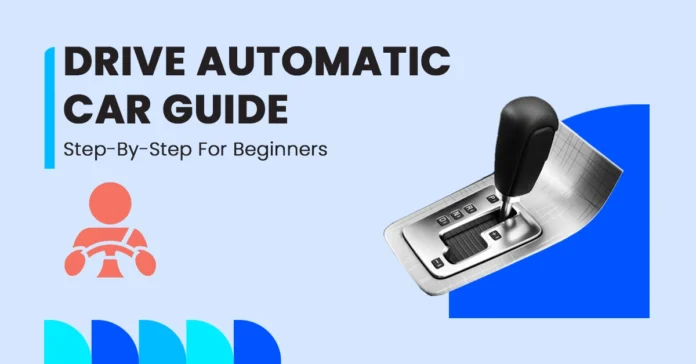Learning how to drive an automatic car is simpler than manual transmission, making it ideal for new drivers. If you’re wondering, “How to drive an automatic car for beginners?”, this guide breaks down driving an automatic car into clear, actionable steps. We’ll cover “How to drive automatic car step by step”, from basic controls to advanced tips. Master the essentials of driving an automatic car safely and efficiently—no clutch required!
Getting Started – Know the Gear Selector
Mastering the gear selector is critical for safe automatic driving. Unlike manual cars, automatic transmissions simplify gear changes but require a precise understanding of these positions:
- P (Park): Engages transmission lock. Always use before exiting to prevent rolling.
- R (Reverse): Activates only when fully stopped to avoid gearbox damage.
- N (Neutral): Disengages drive wheels. Reserve for towing or emergency stops – never at traffic lights!
- D (Drive): Default driving mode. Automatically shifts gears based on speed.
- L/S/± (Manual Mode): Provides engine braking on hills or manual control for overtaking.
Expert Insight: 78% of automatic transmission repairs stem from incorrect gear usage.
How to Drive Automatic Car Step by Step
Now we know about the basic components of an automatic car, it’s time to dig into more details. Following this step-by-step guide will help you feel confident and in control. It has all the essential elements of operating an automatic vehicle, ensuring you know how to drive an automatic car properly.

Step 1: Pre-Drive Preparation
- Adjust seating for clear pedal reach (heel on floor, knee slightly bent)
- Position mirrors to eliminate blind spots
- Fasten seatbelt and ensure passengers do the same
Step 2: Starting the Car
- Press brake pedal firmly with right foot
- Confirm gear in Park (P)
- Start engine:
- Key ignition: Turn key clockwise while holding brake
- Push-button: Press START while braking
- Check dashboard for warning lights before proceeding
⚠️ Critical Safety Feature: Car won’t start unless brake is pressed and gear is in P/N.
Step 3: Engaging Gears
- Keep brake pressed throughout gear changes
- Shift to Drive (D):
- For forward movement
- Gear lever: Press button → move to “D”
- Shift to Reverse (R):
- Only when completely stopped
- Check rearview/side mirrors first
- Manual mode (if available):
- Shift to L/S/± for hills or controlled acceleration
🛑 Never shift between D/R while moving – causes transmission damage!
Step 4: Moving & Speed Control
- Release brake slowly:
- Automatic “creep” moves car at 3-5 mph
- Accelerate gently:
- Right foot: Smooth pressure on accelerator
- Avoid jerky starts – wastes fuel
- Braking technique:
- Gradual pressure for smooth stops
- Left foot off pedals (common beginner mistake)
Step 5: Stopping & Parking
- Complete stop: Apply steady brake pressure
- Shift sequence: D → N → full stop → P
- Secure vehicle:
- Engage the parking brake
- Turn off the ignition
- Check the gear shows “P” before exiting
Key Differences from Manual Cars
| Action | Automatic | Manual |
|---|---|---|
| Starting | Brake + P/N only | Clutch + Neutral |
| Gear Changes | Automatic (or manual mode) | Full manual control |
| Hill Starts | No rollback (creep function) | Clutch/accelerator balance |
| Fuel Efficiency | 10-15% better in city traffic* | Better on highways |
Source: UAE Fuel Efficiency Report 2024
Pro Tips for Beginners
- First-time practice: Use empty parking lots to master pedal sensitivity
- Avoid “dual-footing”: Right foot only for both pedals prevents accidents
- Traffic hack: In bumper-to-bumper traffic, use the creep function instead of constant braking
Did You Know? 87% of UAE driving schools now teach automatic-first due to a simpler learning curve (RTA Data).
Common Mistakes Driving an Automatic Car
If you have been driving a manual car for a while, switching to an automatic one means letting go of old habits. Even those starting with automatic vehicles will need to heed some of the following mistakes:
MISTAKE 1: Treating Brakes Like a Clutch
Why beginners do it: Muscle memory from manual driving
Consequences:
- Violent jerking during stops
- Premature brake wear (50% faster pad erosion)
- Increased whiplash risk
The Fix:
“Rest left foot firmly on dead pedal. Use ONLY right foot for acceleration/braking.”
MISTAKE 2: Riding Brakes in Traffic
Why it happens: Misunderstanding automatic “creep” function
Consequences:
- Brake fluid overheating (critical in UAE summers)
- 30% lower fuel efficiency
- AED 800+ rotor replacement costs
The Fix:
“In stop-and-go traffic: Release brake to creep forward 1-2 car lengths, then re-apply gently.”
MISTAKE 3: Shifting to P/R Before Full Stop
Critical error: Shifting while moving even 3-5 km/h
Consequences:
- Sheared transmission gears
- $2,000+ repair bills
- Vehicle immobilization risk
The Fix:
“ALWAYS: Full stop → 1-second pause → shift direction. Verify 0 km/h on speedometer.”
MISTAKE 4: Neutral Overuse at Stops
Common myth: “Saves fuel at red lights.”
Reality check:
- Wastes more fuel restarting from N→D
- Delays emergency acceleration
- Causes transmission fluid starvation
The Fix:
“Stay in Drive (D) with foot on brake at stops under 60 seconds.”
MISTAKE 5: Two-Foot Driving
Why dangerous:
- Accidental simultaneous pedal press
- 68% higher crash risk (NHTSA data)
- Interferes with electronic safety systems
The Fix:
“Plant left foot on floor. Right foot pivots heel-between pedals.”
Automatic Car Driving License in UAE
Obtaining an automatic car driving license in the UAE does not differ from obtaining a manual one. The UAE’s driving regulations encourage the use of automatic vehicles, which are popular among residents and expatriates alike. To get started, you need to enroll in a recognized driving school that offers comprehensive training tailored specifically for how to drive an automatic car for beginners.
The process generally involves several key steps:
- First, candidates must pass a series of theory tests that cover essential driving rules and safety measures, specifically focusing on areas relevant to automatic cars and driving in the UAE.
- Following this, practical driving lessons will provide hands-on experience in how to drive an automatic car properly, giving learners the skills needed for real-world driving situations.
- Once achieved, this license allows drivers to navigate the roads of the UAE, enjoying the ease of driving with an automatic transmission. After obtaining your license we suggest finding out the best car insurance companies in Dubai for your automatic car which is mandatory in the UAE.
Note: Keep in mind that you can not drive an automatic car with a manual driving license and vice versa.
How to Save Fuel While Driving an Automatic Car
Saving fuel while driving an automatic car is not only economical but also beneficial for the environment. With a few simple adjustments to your driving habits, you can maximize your vehicle’s efficiency and reduce fuel consumption. Here are some effective tips on how to save fuel while driving an automatic car:

- Practice Smooth Acceleration and Braking
- Avoid rapid acceleration; gently press the accelerator for a smoother ride.
- Anticipate traffic flow to reduce the frequency of sudden stops.
- Limit Air Conditioning Use
- Use the car’s ventilation system instead of air conditioning when possible.
- Open windows at lower speeds to keep cool without using the AC.
- Maintain Your Vehicle
- Schedule regular oil changes and ensure a clean air filter to optimize engine performance.
- Keep tires inflated to the correct pressure for better fuel economy.
- Minimize Idling Time
- Turn off the engine if you expect to be stopped for more than a minute, such as at long traffic signals.
Master Your Automatic Driving Journey
Driving an automatic car empowers beginners with a smoother, stress-free experience. By following this step-by-step guide, you will be able to confidently navigate roads, avoid common mistakes, and even save fuel. Ready to start? Practice in safe areas and prioritize regular vehicle maintenance. Share your automatic driving questions or experiences below! If you have more questions about driving an automatic car in the UAE or choosing which types of car insurance for automatic cars, feel free to ask your questions in the comment section.
Frequently Answered Questions
1. How to drive an automatic car as a beginner?
To drive an automatic car properly, learn the gear selector (P, R, N, D), use the brake and accelerator smoothly, and avoid sudden stops or rapid acceleration. Always come to a complete stop before shifting between Drive and Reverse.
2. Can You Drive a Manual Car with an Automatic License?
No, you cannot legally drive a manual car with an automatic license. An automatic license typically restricts you to driving only automatic vehicles.
3. Can You Change Gears in an Automatic Car While Driving?
In most automatic cars, you cannot change gears while driving unless they have a manual mode that allows for gear shifting.
4. Should You Put an Automatic Car in Neutral at Traffic Lights?
It is not necessary to put an automatic car in neutral at traffic lights. Instead, keep the car in Drive (D) and use the brake to maintain a stationary position.
5. What does the gear 1, 2, 3, 4, 5 mean?
Gears 1-5 in automatic cars enable manual control for specialized scenarios:
1-2: Steep hills/heavy towing
3-4: Overtaking or inclines
5: Highway cruising with fuel savings
“Never use manual gears without understanding RPM limits to avoid engine damage.”



